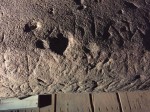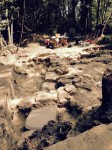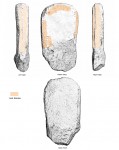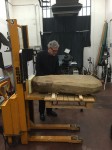 The inscribed Etruscan stele discovered in the ancient settlement of Poggio Colla earlier this year has yielded an exciting name: Uni, a fertility/mother goddess who was the Etruscan equivalent of the Greco-Roman goddesses Hera and Juno. She may have been the goddess worshipped at the temple. Other finds made at Poggio Colla, most famously a ceramic fragment with the earliest birth scene in European art, support the contention that the town was the center of fertility cult.
The inscribed Etruscan stele discovered in the ancient settlement of Poggio Colla earlier this year has yielded an exciting name: Uni, a fertility/mother goddess who was the Etruscan equivalent of the Greco-Roman goddesses Hera and Juno. She may have been the goddess worshipped at the temple. Other finds made at Poggio Colla, most famously a ceramic fragment with the earliest birth scene in European art, support the contention that the town was the center of fertility cult.
 The massive slab was found in the foundation of a 2,500-year-old stone temple, but it was recycled for that purpose. Archaeologists believe the stele was an important part of a sacred display in the first wood temple. It is ponderously sized at 500 pounds, four feet high and two feet wide, and is inscribed with letters and punctuation around the edges of the front face and sides. With the stone partially cleaned the number of characters found was 75. Now they’re up to 120 and still counting, putting it in the running for the longest Etruscan inscriptions on stone. It is certainly one of the three longest sacred (non-funerary) Etruscan texts yet discovered.
The massive slab was found in the foundation of a 2,500-year-old stone temple, but it was recycled for that purpose. Archaeologists believe the stele was an important part of a sacred display in the first wood temple. It is ponderously sized at 500 pounds, four feet high and two feet wide, and is inscribed with letters and punctuation around the edges of the front face and sides. With the stone partially cleaned the number of characters found was 75. Now they’re up to 120 and still counting, putting it in the running for the longest Etruscan inscriptions on stone. It is certainly one of the three longest sacred (non-funerary) Etruscan texts yet discovered.
 When the discovery of the stele was first announced, archaeologists expressed hope that they might discover from the inscription which deity the temple was dedicated to because it’s extremely rare for Etruscan sanctuaries to be so identified. The discovery of the name of the goddess Uni is therefore a wish come true. In addition to the name of the goddess Uni, researchers found the word “tinaś,” which they believe is a permutation of Tina or Tinia, the god of the sky and the top of the divine hierarchy in the Etruscan pantheon. Tina was the Etruscan equivalent of Zeus or Jupiter.
When the discovery of the stele was first announced, archaeologists expressed hope that they might discover from the inscription which deity the temple was dedicated to because it’s extremely rare for Etruscan sanctuaries to be so identified. The discovery of the name of the goddess Uni is therefore a wish come true. In addition to the name of the goddess Uni, researchers found the word “tinaś,” which they believe is a permutation of Tina or Tinia, the god of the sky and the top of the divine hierarchy in the Etruscan pantheon. Tina was the Etruscan equivalent of Zeus or Jupiter.
 Etruscan epigrapher Adriano Maggiani and comparative linguist and University of Massachusetts Amherst classics professor Rex Wallace are studying the inscription and working to translate the text. They’ve found that the text was carved with great care, perhaps by a professional, highly skilled stone carver commissioned to carve words written by a scribe or temple official.
Etruscan epigrapher Adriano Maggiani and comparative linguist and University of Massachusetts Amherst classics professor Rex Wallace are studying the inscription and working to translate the text. They’ve found that the text was carved with great care, perhaps by a professional, highly skilled stone carver commissioned to carve words written by a scribe or temple official.
“This is probably going to be a sacred text, and will be remarkable for telling us about the early belief system of a lost culture that is fundamental to western traditions,” said archaeologist Gregory Warden, co-director and principal investigator of the Mugello Valley Archaeological Project, which made the discovery. […]
“It is also possible that it expresses the laws of the sanctuary — a series of prescriptions related to ceremonies that would have taken place there, perhaps in connection with an altar or some other sacred space,” said Warden[.]
 This is just the early stage of the translation, hence the carefully qualified statements. Mugello Valley Archaeological Project researchers will present the discovery of the goddess Uni in the inscription at an exhibit in Florence on August 27th. The talk will include a hologram of the stele since the stone itself is still in the process of conservation at the Archaeological Superintendency in Florence. Their findings will also be published in the upcoming November issue of the journal Etruscan Studies.
This is just the early stage of the translation, hence the carefully qualified statements. Mugello Valley Archaeological Project researchers will present the discovery of the goddess Uni in the inscription at an exhibit in Florence on August 27th. The talk will include a hologram of the stele since the stone itself is still in the process of conservation at the Archaeological Superintendency in Florence. Their findings will also be published in the upcoming November issue of the journal Etruscan Studies.
“We can at this point affirm that this discovery is one of the most important Etruscan discoveries of the last few decades,” Warden said. “It’s a discovery that will provide not only valuable information about the nature of sacred practices at Poggio Colla, but also fundamental data for understanding the concepts and rituals of the Etruscans, as well as their writing and perhaps their language.”